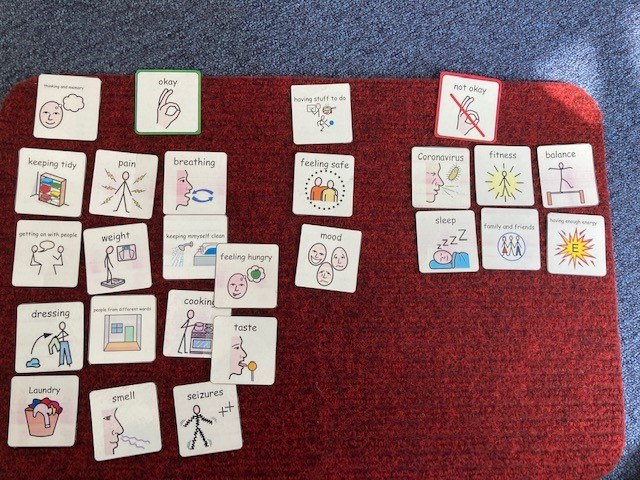We are excited by the growing use and impact of Talking Mats in CAMHS. With this in mind, we have updated our compilation of mental health blogs, and are pleased to share a new compilation with you. If you have used Talking Mats in a mental health setting and would like to share your experiences with us, please do get in touch at info@talkingmats.com – we would love to hear from you!



You can also access the blogs listed above by clicking the following links:
We are delighted to share a poster from Licenced Trainers Brid Corrigan and Libby Mills of NHS Greater Glasgow & Clyde, and Student Speech and Language Therapist Heather Pollock, developed as part of an Impact Project with the University of Strathclyde.
The poster reports on an evaluation of the impact of Talking Mats training on clinical practice across several Child and Adolescent Mental Health Services (CAMHS) in and around Glasgow. We were thrilled to hear the poster had been accepted at the Solving the Mental Health Crisis: Global Solutions Across the Lifespan Conference, held on Friday 21st June.
The project demonstrates how Talking Mats can be used by several members of the multidisciplinary team to build rapport and set goals with young people in both the inpatient and community CAMHS setting. A huge well done to everyone involved in the project for shining a light on how Talking Mats can help to hear the young person’s voice as part of their CAMHS journey.


Talking Mats is delighted to welcome a new Training Associate, Jess Lane. Jess has written this blog to introduce herself to the Talking Mats community. Welcome, Jess, we’re thrilled to have you as part of team TM!
Hello! My name is Jess and I am thrilled to be introducing myself as a newly appointed Training Associate for Talking Mats.
About Me
I am a Specialist Speech and Language Therapist with a clinical background in Learning Disabilities and Paediatric Mental Health. I also work for the Royal College of Speech and Language Therapists (RCSLT) as a Research and Outcomes Officer, where I help to build research capacity, capability and culture within the profession. I am currently studying towards a Clinical Doctorate in Professional Health Studies, looking at the use of Talking Mats for facilitating the direct and meaningful involvement of children in care planning.
Talking Mats has been a huge part of my career to date. This began in my hometown of Gloucester, where I worked as an SLT in an Intensive Support Service for children and adults with learning disabilities. Changes in my personal circumstances saw me relocate to Scotland in 2022, where I worked across Specialist Child and Adolescent Mental Health (CAMHS) Services in and around Glasgow. Most recently, I worked at a National Child Inpatient Psychiatric Unit (CIPU), supporting children with severe and enduring mental illnesses.
Talking Mats in CAMHS
Since completing my Licenced Training last year, I have been working with Talking Mats to deliver Foundation Training for CAMHS teams across the UK, as well as driving an upskilling initiative for Specialist Children’s Services locally in Glasgow. I have found that Talking Mats provides children with a safe space to explore topics that they might otherwise feel unable to communicate about, in a way that is highly supportive, sensitive and impactful. This is encompassed by feedback from a recent patient, who wanted to share that “using a Talking Mat is easier than talking because talking about how you feel can be difficult”.
Many of the children admitted to CIPU present with transient communication difficulties that can exacerbate the impact of mental ill health. Some children present with underlying communication difficulties that were not apparent in the community setting. Other children do not present with communication difficulties, but find it extremely difficult to think about, or share their views on, sensitive topics. Because of this, Talking Mats have been used extensively by the multidisciplinary team on CIPU to:
- Facilitate the direct involvement of patients in goal setting and care planning
- Adapt and extend traditional mental health inventions, including talking therapies
- Support capacity assessments, assessments of mental state and medication reviews
- Improve engagement with local advocacy services as part of the CTO process
- Adapt and extend assessments such as the Child Occupational Self-Assessment Tool
- Improve access to psychoeducation for patients with anxiety and/or depression
- Improve engagement with meal planning for patients with an eating disorder
- Support the differential diagnosis process for mental illnesses such as catatonia

Using Talking Mats in an acute mental health setting has transformed the way clinicians from across Nursing, Psychiatry, Dietetics, Occupational Therapy, Physiotherapy and Psychology engage with the children about their care and treatment. Feedback from the clinical team, children and their parents/carers has been overwhelmingly positive. Talking Mats are now used routinely on the unit to support children’s access to (and engagement with) therapeutic intervention as part of their wider recovery, as well as ahead of all multidisciplinary team meetings and case conferences to ensure each child’s voice is heard and acted upon.
I am so pleased to have joined the Talking Mats team and am very much looking forward to supporting other people to use Talking Mats in a range of settings. Stay tuned for a follow up blog on how I have used Talking Mats as part of a post-diagnostic package of support for autistic children and young people, designed to support more focussed, strengths-based conversations around what it means to be autistic, in line with the core principles of neurodiversity affirming practice.
Thank you to Joan Murphy and Jill Bradshaw for this blog that demonstrates the criteria required for a Talking Mat to be a Talking Mat.
Talking Mats is now an established tool to help people express their views but the way in which is it used can vary and, at times, practitioners may adopt a ‘Talking Mats approach’ which is not truly a Talking Mat.
One of the activities of the Talking Mats Research Network was to establish the criteria which define a ‘true’ Talking Mat and we hope this blog will help clarify that.
The main components of a Talking Mat are
- A space to display the symbols – physical or digital
- A Top Scale
- A Topic for discussion
- Options which relate to the Topic.

In addition, the Research Network identified the following 3 main criteria to verify a Talking Mat:
- Are open questions used within the Talking Mat? For example, ‘How do you feel about x?’ rather than ‘Do you like x ?’ Sorting options into categories is not a true Talking Mat.
- Is the top-scale consistent with Talking Mats principles? The top scale needs to be such that thinkers are able to use the top-scale for reflection when asked an open question relating to a particular option.
3. Is the purpose of the Talking Mat to gain views on a particular topic or issue? The Talking Mat needs to be used in a way that provides an opportunity for the thinker to give their views about the topic. Of course, people with more complex communication challenges may not provide any additional information about their views, other than placing the symbol. However, if the placement of the option is used as a potential opportunity for a discussion, then this can be seen as a Talking Mat.
Further explanation can be found here
Training in Talking Mats covers the criteria and how to achieve it in more detail and is always advised to use this innovative tool to it’s full potential.
Communication is a fundamental human right, yet many individuals with communication difficulties face daily challenges in expressing their thoughts, needs and feelings. Augmentative and Alternative Communication (AAC) is a powerful tool that bridges this communication gap, and Talking Mats is one innovative approach that has proven highly effective in enhancing the lives of those who use AAC.
However, in the 25 years that Talking Mats has been developing resources we have never created one that specifically addresses the needs of AAC users.
Until now!
The new resource, Supporting Communication with AAC and the online advanced training module, AAC will be launched at this year’s Communication Matters Conference 9th-11th September.
The idea
Ace Centre first contacted us in 2018 with the idea of developing a specific assessment resource that would allow the person considering using AAC to express their views about it; were they ready to use AAC, did it fit with their life and communication needs and how much support would be required? This could then inform decisions around referrals onto specialist AAC services.
Development
As with all Talking Mats resources, this one was piloted and discussed and changed until the final version was reached. Thank you to all the practitioners and clients who gave their time and energy in that process. Thank you also to the Scottish Centre of Technology for the Communication Impaired who also collaborated on the resource and the module.
Outcome
The outcome is a resource that can contribute to both assessments and reviews, and an Advanced online training module, both of which aim to put the AAC user at the heart of decision making about their communication.
Here is a brief outline of the resource and the module.
Supporting Communication with AAC (card and digital resource)
Topics
Your Communication

This topic considers the ‘How’, ‘Who’ and ‘Where’ of interactions and helps develop an understanding of the Thinkers communication needs. It can be completed when you are getting to know the Thinker.
Joining in conversations

These topics are designed to help a Thinker explore how they feel about their AAC resource when it comes to joining in conversations and reflect the fact that an individual often uses a combination of communication modes to be effective. The three topic cards are: Verbal conversation, Paper support and Electronic Support.
How your AAC works
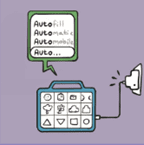
This topics explores different ways of accessing the AAC device as well as the different features it has, incluing functions, appearance, sound, and access.
If you are trained in Talking Mats to Foundation level you can buy the resource from our website
AAC Advanced module
To access this course you must have already completed the Foundation Course.
The objective of this course is to ensure that AAC users are at the heart of decision making and that necessary adaptations are in place to support those conversations
The course is split into three different sections:
The Resource
Aim – to recognise the different topics and who they might be suitable for
Access
Aim – to recognise different positions, places and methods for a Thinker to access a Talking Mat
Communication Dynamics
Aim – to recognise the dynamics in a conversation, and appraise the process of using additional people during a Talking Mat
To successfully complete the course participants must pass the quiz and contribute to the forum telling us about their experience.
Courses will run from the 1st of every month starting in November.
It’s that time of year; the days are longer, there are lambs in the fields, the grass is getting cut and people are thinking about new beginnings. Maybe you want to embrace the Spring momentum and get a new skill under your belt, the one you’ve been hearing about from colleagues and reading about on social media; Talking Mats!
Talking Mats has been busy and there are new resources about to be launched but they have the line ‘only available to those trained in Talking Mats’. You attended something a few years ago and you think something was said that had something to do with Talking Mats – does that count? And it’s just pictures how hard can it be?
If this sounds like a conversation you’ve had with yourself read this blog to find out why training in this innovative communication tool is recommended.
I need this training; how can I get it?
You’ve made the decision that you’ll get trained in Talking Mats. What options are there to let you do this? Like all training providers over the last 3 years Talking Mats has had to adapt our training provisions. We have also had to be responsive to what our customers want; there is a much bigger demand for virtual training and online training than we experienced pre 2020. To reflect this we currently offer a variety of ways you can access our Foundation Training. Your choice will depend on the answers to several questions; what sort of learner are you? Can you do this as part of your working day or will it be in your own time? Can you apply for study leave? Following from that; would you like to buy a resource with your training and what is available ? The following diagrams should help simplify things and more in depth information about Foundation Training is on our website, as well as booking information. Being trained in Talking Mats allows you to access all our Advanced Courses and Resources and go on to become a Licenced Trainer.
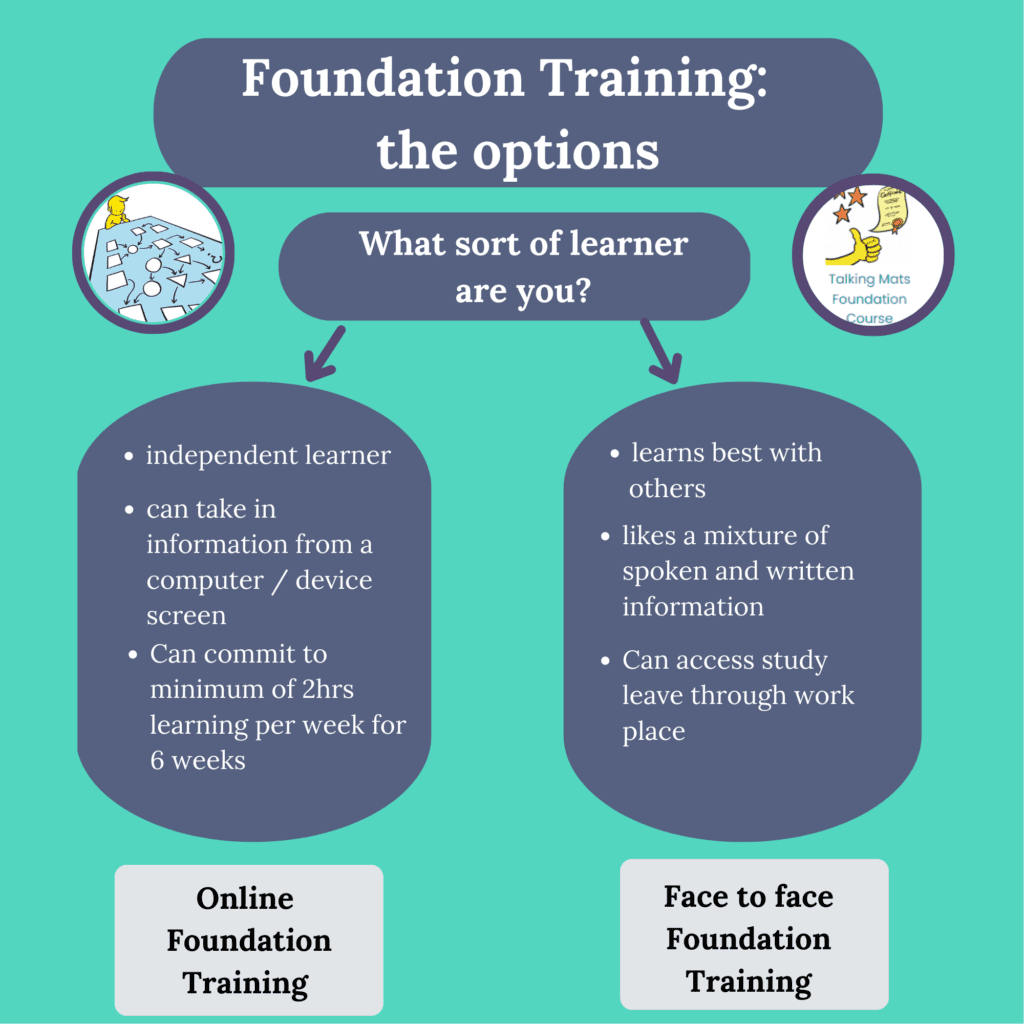
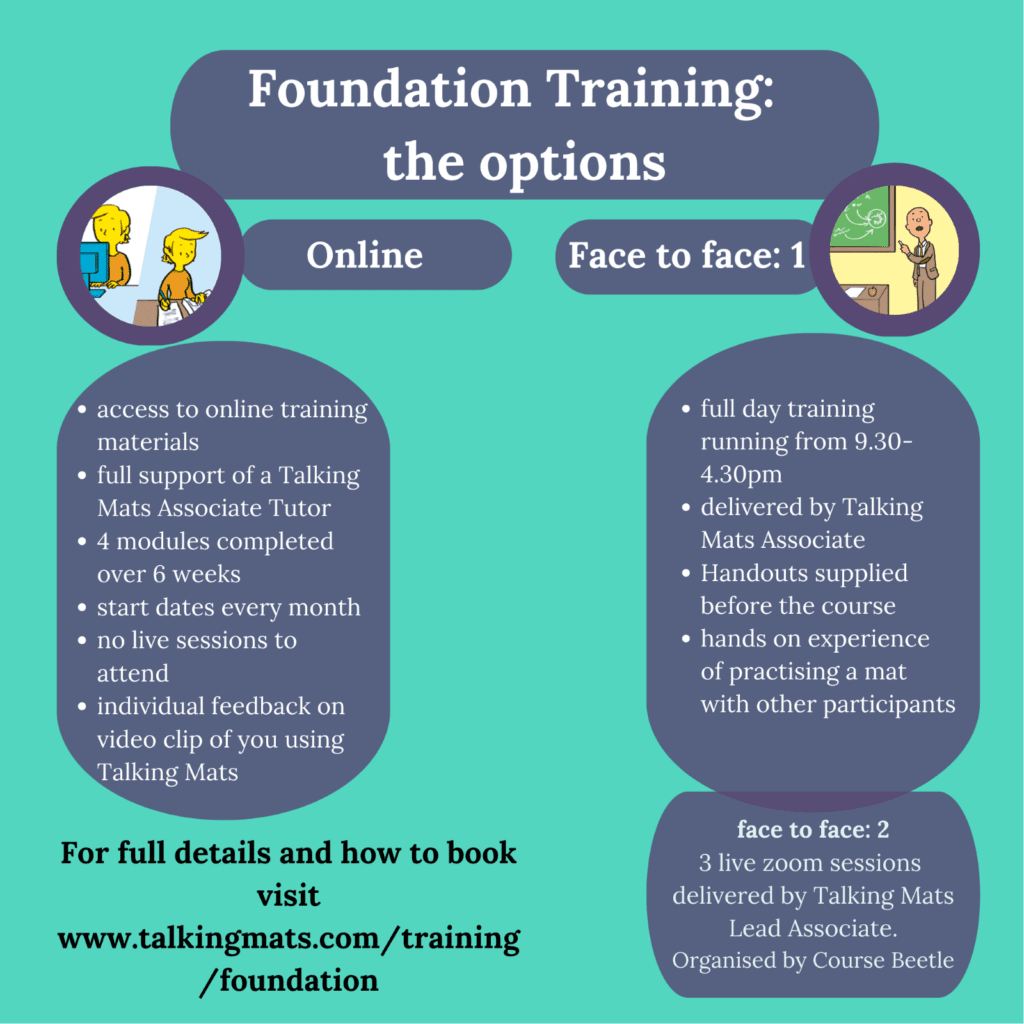
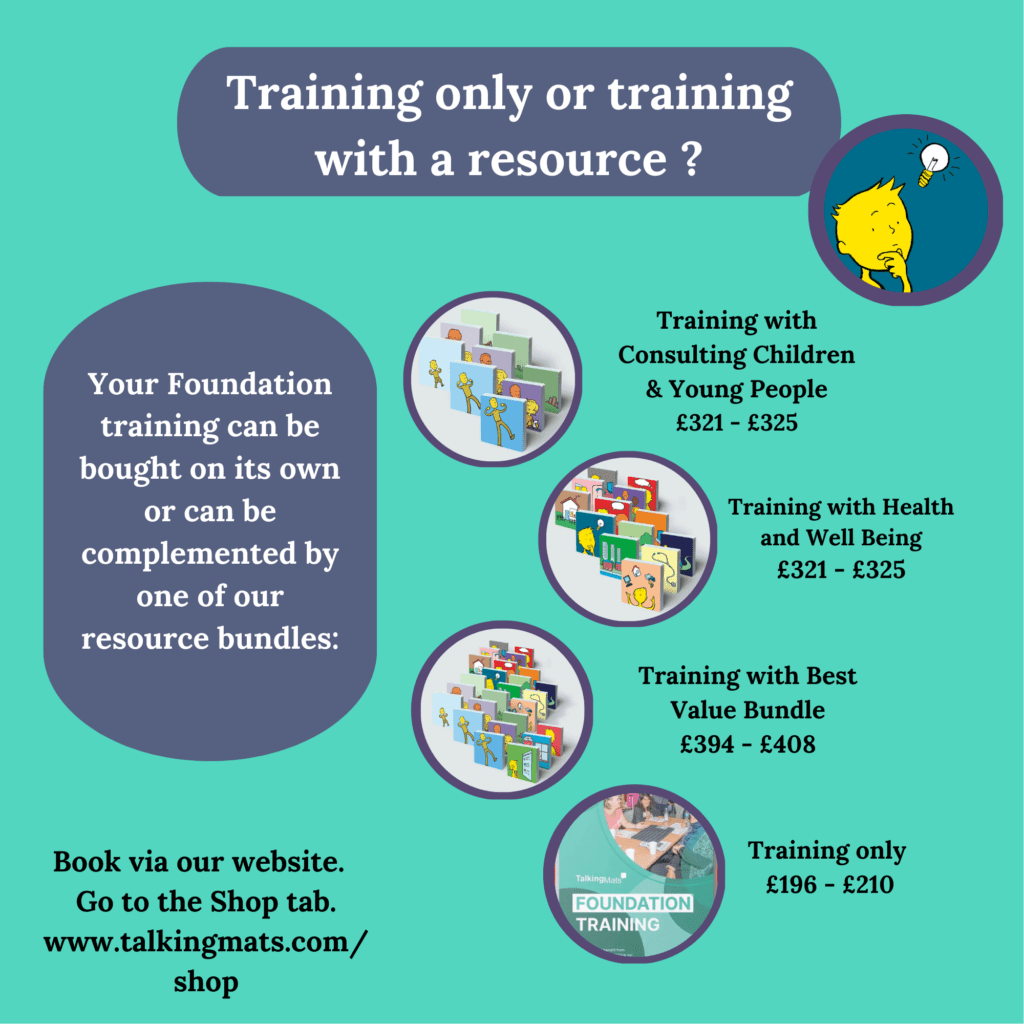
Manchester 30th June 2022.
It has been a long time since our Associates have been able to deliver training in a venue that is not virtual (to be accurate usually their kitchen / bedroom / garden shed). We are really pleased, therefore, to be able to let you all know that face to face training has returned! We know the convenience of online suits some people but many of you have been really missing the interaction, the energy and the discussion that occurs in a face to face training and we are looking forward to getting back to working with you in the same room.
It will be held in the St. Thomas Centre, Manchester on the 30th of June from 9.30am until 4.30pm. Find out more about what to expect on this course by following this link Manchester June 2022.
Talking Mats will take every step required to keep all participants and staff safe in this situation. Please let us know if there is anything we can do to support you to attend this course.
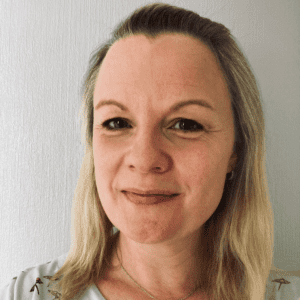
This course will be run by Laura Holmes, Lead Associate with responsibility for Foundation Training. She has been training with us since 2016. Here are her thoughts on resuming face to face training;‘I get so much out of face to face training; particpants form relationships quickly and really respond to each other and it creates a special learning environment.’
There are only 12 places on this course and we expect them to be taken up quickly.
To book please follow this link BOOK HERE.
The Talking Mats Foundation Training is a course that builds people’s confidence in using and applying Talking Mats to their work. Organisations can access this as a group ensuring staff can embed the Talking Mats approach and principles into their practice. The training also gives staff a common language for embedding a patient centred approach at the heart of a service.
We offer online training by;
- giving organisations access to our online training platform – this is designed as self-directed course, supported by a Talking Mats tutor, with a variety of activities and resources to support learning
- zoom/teams sessions
- a combination of both 1 and 2.
2020 saw an increase in organisations approaching Talking Mats for online team training and this has continued into 2021. We will work with you to find the approach that best suits your staff group.
Online learning does not suit everyone and comments from participants are mixed. Some really like the flexibility of being able to work at their own pace and find the site user friendly whilst others miss the interaction that face-to-face brings. As a team we miss the face-to-face training too but believe that our online training and the support we offer organisations is an excellent alternative.
It is easier to discuss the impact of an organisational course by giving an example. We recently ran a course using our online learning platform combined with short introductory and a follow-up session on Zoom for 24 staff working in an NHS Paediatric service. Taking part on the course were Nurses, Psychologists, Occupational Therapists, Physiotherapists, Dieticians and Speech and Language Therapists. It was great working with such a multidisciplinary group. They all have communication at the heart of their practice and were keen to learn about a framework that could help them improve the effectiveness of their work. There were different reasons for doing the course, but a common theme was wanting to have more ways of directly engaging and building relationships with the children they were working with rather than relying mostly on carer views. They wanted to be able to involve young people more meaningfully in some of the complex issues that surrounded their care.
It is always positive when a course has immediate impact and this staff group applied their learning in very different ways, for example Talking Mats was used to;
- communicate with a young person with selective mutism,
- involve a young woman who was self-harming to contribute to the strategies that help her reduce those behaviours ,
- involve children in physiotherapy interventions.
One course participant said ‘I have practised with a couple of patients and it has made a massive impact on their lives already. One patient’s behaviours have dramatically reduced as I was able to support her to show how she felt about aspects of her care and resolve this.’ And another participant said ‘I have now used Talking Mats with a couple of young people with complex neurodevelopmental difficulties and this has helped engagement considerably, where things had felt stuck before’
An important part of Talking Mats training is to help participants think about their own communication style and how it impacts on interactions and relationships. Staff said;
- this course increased my awareness of my communication style and made me reflect more on how I communicate with my patients but also what I presume from my patients.
- I am more aware of the communication demands I place on others as a clinician/therapist and am more confident in engaging people with communication difficulties.
- It has made me think more about the language that i use during interactions.
- It has definitely made me reflect on my own style of questioning, and helped improve my pacing and language skills.
The feedback from this varied and engaged group of staff was positive and is summed up in this comment; ‘The course was very engaging, interesting, and easy to follow and understand. I have learned a lot from this. The reflective work throughout the modules really helped to connect the theory with the practice of Talking Mats. The course leaders were very involved, supportive and helpful!’
Our training is relevant to organisations working within Social Work, Advocacy, Dementia Support and Education as well as Health and Social Care. If you think you would like to organise a course for your staff group please get in touch at info@talkingmats.com to talk it through.
Many thanks to Edith Barrowcliffe from The Action Group for sharing her experiences of using Talking Mats to support counselling with adults who have cognitive or communication difficulties. Watch this space for Edith’s follow-up blog next week which will describe how she has continued to use Talking Mats during lockdown. Please note that the image used in this blog is from a mock session and has been taken for publicity purposes only.
Eleven years ago, I began working at The Action Group with adults who have additional support needs and was struck by how many had mental health difficulties that they were getting little help with. Sadly, with services scarce enough for the “mainstream” population, I could see why.
The issue resurfaced for me in 2016 when I began training as a counsellor. I kept returning to whether talking therapy was possible with those who had difficulty communicating – or even thinking about – their feelings.
Then in 2019, I attended Talking Mats training. Immediately excited by the potential for emotional connection, I signed up for the advanced “Keeping Safe” training and approached The Action Group’s CEO with the beginnings of a plan.
I’m fortunate in working for an organisation willing to take new ideas and run with them. Within six months I was embarking on a pilot project, called HearMe, offering counselling to adults with cognitive or communication difficulties, with Talking Mats as a key method to help overcome those barriers. Within a fortnight of opening the service was full to its limited capacity and had a waiting list!
The work has been experimental, learning as I go and adapting to the particular needs of each client. To conduct initial assessments, I’ve assembled symbols based on “Thoughts and Feelings” from the “Keeping Safe” pack. We return to this to review progress. Most clients have used a top scale of “True”/ ”Not True” with statements “about me” for the assessment. We always begin with a practice mat based on more neutral material, allowing the client (Thinker) to learn what’s involved and me to gauge whether the mat is right for them. This is crucial – one client found a way to frame everything we placed on the mat positively even when they’d been able to tell me the opposite was true a moment before! In this case we simply used each symbol as a focus for exploration.
We’ve kept the number of questions relatively small, but the assessment can take two or three sessions to complete as clients often respond quite deeply to the symbols.
Some more verbally able clients move on to a more “freeform” style of counselling as we progress, relying less on the mat to open up. But even in these cases having symbols on hand can be helpful. One client brought up the topic of sex – then apologised and asked if it was OK to talk about it.
“It’s fine,” I was able to reassure her, producing the relevant symbol. “Look, we even have a picture for it”. She laughed and visibly relaxed, the card giving her tangible evidence that the topic was allowed.
It’s still early days, but from the feedback we’ve received so far, the project really seems to be helping people to open up, express feelings they’ve never given space to before, and explore ways they want to change their lives. The power of simply being heard.
Edith Barrowcliffe, Hear Me, The Action Group
With thanks to our funders and partners for making this work possible – Hospital Saturday Fund, The Action Group Board, Leith Benevolent Society, Port o’Leith Housing Association, and The Scottish Government. And to the team at Talking Mats for their support and help!
Follow the link below to find out more about our Keeping Safe training (now available online) and resource:
https://www.talkingmats.com/keeping-safe-a-new-talking-mats-resource-available-to-purchase/
As a group of Allied Health Professionals (AHPs) working in a secure hospital we recently embarked on a mini project using Talking Mats to check in with our service users with learning disabilities during Covid-19. We collated the evidence from our respective professional bodies (Royal College of Occupational Therapy, Royal College of Speech and Language Therapy, Chartered Society of Physiotherapists and British Dietetic Association) in terms of changes that people might experience if they’d had Covid-19 and produced a talking mat around these.
It quickly dawned on us that we might be on to something here, and that creating an opportunity to ‘check in’ more broadly with our service users would serve a useful purpose, so we added some additional categories around changes to routine, psychological wellbeing and feeling safe.
This was my colleagues’ first experience of using talking mats, and their faces when I turned up clutching my 99p actual doormat were a picture! I introduced them to the theory behind the mat and its presentation and harped on about the benefits in terms of attention, comprehension, non-threatening interaction, initiation and structuring narrative; they nodded supportively.
We set off across our learning disability wards in multi-disciplinary pairs and all but a few of the service users agreed to have a chat with us. My colleagues commented that they were pleasantly surprised by the engagement and the amount and novelty of the information gained; we identified things that the service users hadn’t told anyone because they hadn’t been asked that question!
In talking to others we were asked why weren’t rolling this out in a partner secure hospital for people with mental health conditions? ‘no reason really, we just haven’t got there yet’ we answered. Then came the…. but we can just do it like a questionnaire with them. This question wasn’t, and in my experience isn’t ever ill meant. It comes from a place of naivety in relation to the presence of communication difficulties in people with mental health conditions and because of that, lack of exposure to different professional groups such as Speech and Language Therapy and the skills and approaches we have to offer. Skills in gaining and holding someone’s attention. Skills in decreasing pressure in communication situations. Skills in enabling time, space and ways in which people can initiate their thoughts.
The Multi-Disciplinary Team (MDT) working around the project has enabled me to show others how talking mats can support their practice. It has enabled them to see how a very simple and non-threatening visual tool can open up conversations and lead to information that the service users hadn’t shared before, in a way that a face to face conversation doesn’t.
Thanks to Jo Brackley, Clinical Lead, Speech and Language Therapy Secure Services at Cumbria, Northumberland Tyne and Wear NHS Foundation Trust for this inspiring blog – which demonstrates when we shift the way we listen and gather information from patients we get a different result and improve the quality of information and communication . If you or your team want to consider Talking Mats training then we can provide this for organisations . At the moment we can take a cohort through our online course together and then arrange a zoom call to discuss application to your work setting – email info@talkingmats.com for more information.
 Online training login
Online training login 

